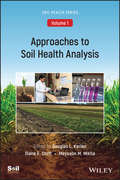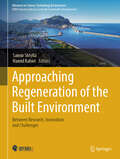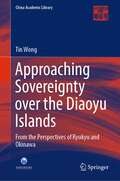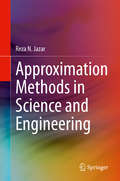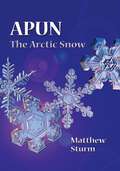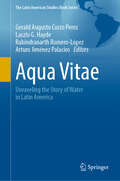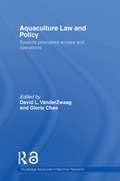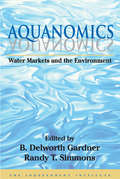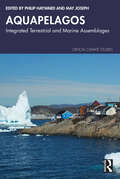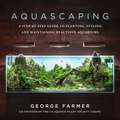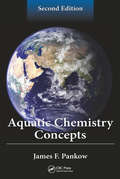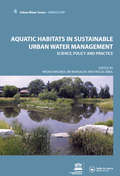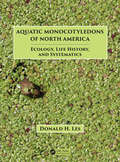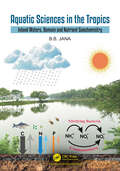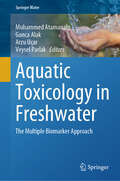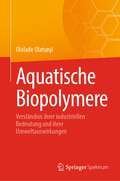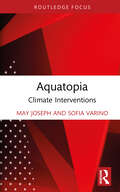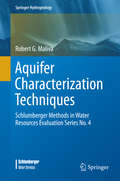- Table View
- List View
Approaches to Soil Health Analysis (ASA, CSSA, and SSSA Books #190)
by Douglas L. Karlen Diane E. Stott Maysoon M. MikhaApproaches to Soil Health Analysis A concise survey of soil health analysis and its various techniques and applications The maintenance of healthy soil resources provides the foundation for an array of global efforts and initiatives that affect humanity. Whether they are working to combat food shortages, conserve our ecosystems, or mitigate the impact of climate change, researchers and agriculturalists the world over must be able to correctly examine and understand the complex nature of this essential, fragile resource. These new volumes have been designed to meet this need, addressing the many dimensions of soil health analysis in chapters that are concise, accessible and applicable to the tasks at hand. Soil Health, Volume One: Approaches to Soil Health Analysis provides a well-rounded overview of the various methods and strategies available to analysists, and covers topics including: The history of soil health and its studyChallenges and opportunities facing analysistsMeta-data and its assessmentApplications to forestry and urban land reclamationFuture soil health monitoring and evaluation approaches Offering a far-reaching survey of this increasingly interdisciplinary field, this volume will be of great interest to all those working in agriculture, private sector businesses, non-governmental organizations (NGOs), academic-, state-, and federal-research projects, as well as state and federal soil conservation, water quality and other environmental programs.
Approaching Regeneration of the Built Environment: Between Research, Innovation and Challenges (Advances in Science, Technology & Innovation)
by Saimir Shtylla Hamid RabieiThis book approaches three important aspects related with urban regeneration such as research, innovation and challenges. In light of its growing interdisciplinarity, the selected contributions extend the debate to the importance of the cooperation between various disciplines, attention to the latest design and technological trends, as well major inclusivity of citizens for a correct decision-making process leading afterwards into successful development, test and implementation of innovative solutions. An important focus will be set on the important role innovations play in the preservation and management of heritage sites in response to the climate and urban challenges encountered. Also, this contribution aims to transmit the importance of local interventions in the achievement of urban regeneration as an impulse for the achievement of the common global climate goals in the years ahead.
Approaching Sovereignty over the Diaoyu Islands: From the Perspectives of Ryukyu and Okinawa (China Academic Library)
by Tin WongThis book discusses the sovereignty over the Diaoyu Islands from the perspectives of Ryukyu and Okinawa. Written in chronological order, the book has 13 chapters featuring 121 documents and maps. The first 12 chapters explain, based on detailed historical facts on the Diaoyu Islands, the rise and decline of the Ryukyu Kingdom and the historical roles of China, Japan, and the United States in the history of the kingdom. The final chapter is an overview of the Sino-Ryukyuan, Japan-Ryukyuan and US-Ryukyuan relations, and further clarifies the issue of ownership of the Diaoyu Islands and their strategic position. The book demonstrates that Ryukyu did not have sovereignty over the Diaoyu Islands, refutes Japan’s claim that these islands were a part of the Ryukyu Kingdom, and reveals the causes and consequences of the Sino-Japanese conflicts created by the United States. The book examines the 500-year friendship between China and Ryukyu, recounting moving stories. Lastly, citing ancient documents and more, the books proves that the Ryukyus never owned the Diaoyu Islands and that these islands belong to China.
Approximation Methods in Science and Engineering
by Reza N. JazarApproximation Methods in Engineering and Science covers fundamental and advanced topics in three areas: Dimensional Analysis, Continued Fractions, and Stability Analysis of the Mathieu Differential Equation. Throughout the book, a strong emphasis is given to concepts and methods used in everyday calculations. Dimensional analysis is a crucial need for every engineer and scientist to be able to do experiments on scaled models and use the results in real world applications. Knowing that most nonlinear equations have no analytic solution, the power series solution is assumed to be the first approach to derive an approximate solution. However, this book will show the advantages of continued fractions and provides a systematic method to develop better approximate solutions in continued fractions. It also shows the importance of determining stability chart of the Mathieu equation and reviews and compares several approximate methods for that. The book provides the energy-rate method to study the stability of parametric differential equations that generates much better approximate solutions.
Approximation with Quasi-Splines
by G.H KirovIn the theory of splines, a function is approximated piece-wise by (usually cubic) polynomials. Quasi-splines is the natural extension of this, allowing us to use any useful class of functions adapted to the problem.Approximation with Quasi-Splines is a detailed account of this highly useful technique in numerical analysis.The book presents the requisite approximation theorems and optimization methods, developing a unified theory of one and several variables. The author applies his techniques to the evaluation of definite integrals (quadrature) and its many-variables generalization, which he calls "cubature."This book should be required reading for all practitioners of the methods of approximation, including researchers, teachers, and students in applied, numerical and computational mathematics.
Apun: The Arctic Snow
by Matthew SturmThere are some twenty-five words for “snow” in the Inupiaq language. Each word denotes a different kind of snow—fresh powder snow, hard pack, soft snow, very wet snow, or just snow. Such fine distinction is reasonable, for over the centuries, Natives of the Arctic have had to rely on their knowledge of the snow to survive. Now Matthew Sturm has prepared an educational children’s book designed to teach a new generation of Arctic residents the importance of Arctic snow cover. Fully illustrated to demonstrate the cycle of the snow cover, Apun covers each phase of the “snow year.” Geared towards grades 3–4, this is a must read for elementary science classes.
Aqua Vitae: Unraveling the Story of Water in Latin America (The Latin American Studies Book Series)
by Gerald Augusto Corzo Perez Laszlo G. Hayde Rabindranarth Romero-López Arturo Jiménez PalaciosThis comprehensive book presents an analytical journey through the relationship between water and Latin American societies, offering an engineering perspective on historical water resource utilization. The book unravels the integral role water has played in the cultural, technological, and socio-economic development of the region, providing a foundational reference for engineers, academics, and researchers. The book's exploration into water's perception and usage throughout history provides key insights into how human activity has impacted water resources and vice versa. It presents a meticulous examination of water as both a natural and cultural phenomenon, identifying its essential role in sustaining life and ecosystems, as well as its potential for causing devastation through disease and natural disasters. We delve into the complexities of water's role in society, illustrating how it is woven into the fabric of everyday life, religious ceremonies, and global events. The book also underscores the varying significance and implications of water across different regions within Latin America. The narrative unfolds across three major sections: Technology, Water Management, and Socio-Cultural-Economical Impact. The 'Technology' section examines the evolution of water-related technologies and their significant socio-economic implications. The 'Water Management' part offers a holistic perspective on water resource management practices, both historical and contemporary. The final section delves into the societal implications of water use, including conflicts arising from political and economic decisions related to this crucial resource. Designed for engineers, environmental scientists, and policy-makers, this book provides a unique blend of historical context, technical knowledge, and socio-cultural insights. It offers an invaluable resource for those seeking to understand the interplay between engineering practices, water resources, and societal developments in Latin America. It serves as a springboard for further research and informed decision-making in water resource management and policy, fostering a greater understanding of the myriad ways in which water influences and is influenced by human activity.
Aquaculture Law and Policy: Towards principled access and operations (Routledge Advances in Maritime Research)
by Gloria Chao David L. VanderZwaagThe aquaculture industry is fast expanding around the globe and causing major environmental and social disruptions. The volume is about getting a 'good governance' grip on this important industry. The book highlights the numerous law and policy issues that must be addressed in the search for effective regulation of aquaculture. Those issues include among others: the equitable and fair assignment of property rights; the design of effective dispute resolution mechanisms; clarification of what maritime laws apply to aquaculture; adoption of a proper taxation system for aquaculture; resolution of aboriginal offshore title and rights claims; recognition of international trade law restrictions such as labeling limitations and food safety requirements; and determination of whether genetically modified fish should be allowed and if so under what controls. This book will appeal to a broad range of audiences: undergraduate and postgraduate students, academic researchers, policy makers, NGOs, practicing lawyers and industry representatives.
Aquanomics: Water Markets and the Environment (Independent Studies In Political Economy Ser.)
by Randy T. Simmons B. Delworth GardnerWater is becoming increasingly scarce. If recent usage trends continue, shortages are inevitable. Aquanomics discusses some of the instruments and policies that may be implemented to postpone, or even avoid, the onset of water crises. These policies include establishing secure and transferable private water rights and extending these rights to uses that traditionally have not been allowed, including altering in-stream flows and ecosystem functions. The editors argue that such policies will help maximize water quantity and quality as water becomes scarcer and more valuable. Aquanomics contains many examples of how this is being accomplished, particularly in the formation of water markets and market-like exchanges of water rights.Many observers see calamity ahead unless water supplies are harnessed and effectively conserved, and unless water quality can be improved. It is also clear that declining water quality is a serious problem in much of the world, as increasing human activities induce high levels of water degradation. Those who voice these concerns, argue the contributors to this volume, fail to consider the forces for improvement inherent in market political-economic systems that can address water issues. The contributors see water quality in economically advanced countries as improving, and they believe this establishes the validity of market-based approaches.
Aquapelagos: Integrated Terrestrial and Marine Assemblages (Critical Climate Studies)
by Philip Hayward and May JosephAquapelagos is a cross-disciplinary volume that is geared to a general undergraduate and non-specialist readership while also being rigorous and theoretically exciting for doctoral and advanced researchers of climate and ocean studies. It foregrounds marine-terrestrial assemblages as philosophical, navigational, and knowledge-making interfaces.Drawing on ethnographic, geographic, architectural, sociological, and scientific methodogies, Aquapelagos sheds light on varied approaches, dialogues, and responses to the catastrophic and impending futures unfolding across waterfronts from the Andaman Islands, Maldives, and Indonesia to the Grand Banks and the Juan Fernandez Islands. It delves into pressing issues of human interrelations with aquatic environments, ocean volatility, ocean toxicity, flooding, inundation, mitigation, rising seas, and climate adaptation in interdisciplinary and comparative global terms. Within the conceptual framework of the aquapelago, the contributors to this volume explore aspects of integrated terrestrial and marine assemblages that enhance our understanding of the impact of global climate change and related rising sea levels on diverse planetary ecologies and the societies that depend on them.The volume will be of interest to scholars, researchers, and students of ethnography, social anthropology, climate action, development studies, public policy, and climate change.
Aquascaping: A Step-by-Step Guide to Planting, Styling, and Maintaining Beautiful Aquariums
by George FarmerLearn how to create and maintain your own underwater ecosystem. Aquascaping is the art of creating beautiful aquariums with natural materials and live plants. From the brilliance of Takashi Amano and numerous other innovators, aquascapes have become a popular way to enjoy aquariums. In Aquascaping: A Step-by-Step Guide to Planting, Styling, and Maintaining Beautiful Underwater Aquariums, planted aquarium expert George Farmer teaches how to create the perfect aquascape. Included in this book are full-color photographs that will supply readers with: Step-by-step instructions on setting up your tankDifferent styling suggestions that best suit your landscapeHow to pick plants, rocks, driftwood, substrate, and aquatic lifeUnderstanding the chemistry and biology involved in keeping a healthy aquariumMaintenance and upkeepAnd much more Creating an underwater ecosystem is not only a rewarding experience, but can bring much peace and relaxation to your life. So whether you&’re a novice aquarist or seasoned aquascaper, Aquascaping will teach you all the tricks of the trade so that your beautiful aquarium can be enjoyed by family, friends, and, most importantly, yourself.
Aquatic Biodiversity Conservation and Ecosystem Services (Ecological Research Monographs)
by Shin-Ichi Nakano Tetsukazu Yahara Tohru NakashizukaThis volume examines the topic of local biodiversity conservation in the Asia-Pacific region, one of the most rapidly changing areas in the world. With a focus on aquatic systems, this book offers insight on the state of local biodiversity, challenges in management and conservation of biodiversity, and newly developed methods for monitoring biodiversity. In addition, because the service provided by an ecosystem for humans is interlinked with conservation, the final part is dedicated to evaluating the socioeconomic aspect of ecosystem services, with special reference to local biodiversity. In effect, all contributions provide information that is invaluable for effective conservation and sustainable use of biodiversity. This work will interest all stakeholders in biodiversity conservation, including policy makers, NPOs, NGOs, environment-related industries, and biodiversity researchers, not only in the Asia-Pacific region, but also across the entire globe.
Aquatic Chemistry Concepts, Second Edition
by James PankowAquatic Chemistry Concepts, Second Edition, is a fully revised and updated textbook that fills the need for a comprehensive treatment of aquatic chemistry and covers the many complicated equations and principles of aquatic chemistry. It presents the established science of equilibrium water chemistry using the uniquely recognizable, step-by-step Pankow format, which allows a broad and deep understanding of aquatic chemistry. The text is appropriate for a wide audience, including undergraduate and graduate students, industry professionals, consultants, and regulators. Every professional using water chemistry will want this text within close reach, and students and professionals alike will expect to find at least one copy on their library shelves. Key Features Extremely thorough, one-of-a-kind treatment of aquatic chemistry Discussions of how to carry out complex calculations regarding the chemistry of lakes, rivers, groundwater, and seawater Numerous example problems worked in complete detail Special foreword by Jerry L. Schnoor
Aquatic Dicotyledons of North America: Ecology, Life History, and Systematics
by Donald H. LesAquatic Dicotyledons of North America: Ecology, Life History, and Systematics brings together a wealth of information on the natural history, ecology, and systematics of North American aquatic plants. Most books on aquatic plants have a taxonomic focus and are intended primarily for identification. Instead, this book provides a comprehensive overview of the biology of major aquatic species by compiling information from numerous sources that lie scattered among the primary literature, herbarium databases, and other reference materials. Included dicotyledon species are those having an obligate (OBL) wetland status, a designation used in the USACE National Wetland Plant List. Recent phylogenetic analyses are incorporated and rationale is provided for interpreting this information with respect to species relationships. This diverse assemblage of information will be useful to a wide range of interests including academic researchers, wildlife managers, students, and virtually anyone interested in the natural history of aquatic and wetland plants. Although focusing specifically on North America, the cosmopolitan distribution of many aquatic plants should make this an attractive text to people working virtually anywhere outside of the region as well. This book is an essential resource for assisting with wetland delineation.
Aquatic Habitats in Sustainable Urban Water Management: Urban Water Series - UNESCO-IHP
by Iwona Wagner; Jiri Marsalek; Pascal BreilAquatic habitats supply a wide range of vital ecosystem benefits to cities and their inhabitants. The unsustainable use of aquatic habitats, including inadequate urban water management itself, however, tends to alter and reduce their biodiversity and therewith diminish their ability to provide clean water, protect us from waterborne diseases and po
Aquatic Mesocosm Studies in Ecological Risk Assessment
by Robert L. GraneyA Special Publication of the Society of Environmental Toxicology and Chemistry (SETAC)Aquatic Mesocosm Studies in Ecological Risk Assessment discusses the methods currently used for conducting simulated field studies and provides a series of case histories in which mesocosm type studies have been used to assess the impact of pesticides on aquatic ecosystems. Specific chapters address the dosing and exposure components of such studies and how they influence experimental design. Advantages and disadvantages of various statistical designs are addressed in detail. Regulatory aspects of the design and interpretation of these studies are also covered. The book will be a superb reference for aquatic biologists, ecologists, toxicologists, environmental toxicologists, environmental chemists, and regulatory personnel.
Aquatic Microbial Ecology and Biogeochemistry: A Dual Perspective
by Patricia M. Glibert Todd M. KanaThis book highlights perspectives, insights, and data in the coupled fields of aquatic microbial ecology and biogeochemistry when viewed through the lens of collaborative duos - dual career couples. Their synergy and collaborative interactions have contributed substantially to our contemporary understanding of pattern, process and dynamics. This is thus a book by dual career couples about dual scientific processes. The papers herein represent wide-ranging topics, from the processes that structure microbial diversity to nitrogen and photosynthesis metabolism, to dynamics of changing ecosystems and processes and dynamics in individual ecosystems. In all, these papers take us from the Arctic to Africa, from the Arabian Sea to Australia, from small lakes in Maine and Yellowstone hot vents to the Sargasso Sea, and in the process provide analyses that make us think about the structure and function of all of these systems in the aquatic realm. This book is useful not only for the depth and breadth of knowledge conveyed in its chapters, but serves to guide dual career couples faced with the great challenges only they face. Great teams do make great science.
Aquatic Monocotyledons of North America: Ecology, Life History, and Systematics
by Donald H. LesThis book brings together information on the natural history, ecology and systematics of North American aquatic monocotyledons. The book is an overview of the biology of major aquatic species by compiling information from numerous sources that lie scattered among the primary literature, herbarium databases, and other reference sources. Information on more than 300 species in 87 genera of monocotyledons will be included. Recent phylogenetic analyses will be incorporated. Although focusing specifically on North America, the cosmopolitan distribution of many aquatic plants should make this an attractive text to people working virtually anywhere outside of the region as well. Key Selling Features: The primary source of natural history information on aquatic plants Comprehensive lists of ecological associates Synthetic overview of systematic relationships of aquatic species and genera Practical information for rare and invasive plant managers Essential guide to facilitate wetland delineation
Aquatic Organic Matter Fluorescence
by Paula G. Coble Jamie Lead Andy Baker Darren M. Reynolds Robert G. M. Spencer Paula G. Coble Jamie Lead Andy Baker Darren M. ReynoldsThis is the first comprehensive text on the theory and practice of aquatic organic matter fluorescence analysis, written by the experts who pioneered the research area. This book covers the topic in the broadest possible terms, providing a common reference for making measurements that are comparable across disciplines, and allowing consistent interpretation of data and results. The book includes the fundamental physics and chemistry of organic matter fluorescence, as well as the effects of environmental factors. All aspects of sample handling, data processing, and the operation of both field and laboratory instrumentation are included, providing the practical advice required for successful fluorescence analyses. Advanced methods for data interpretation and modeling, including parallel factor analysis, are also discussed. The book will interest those establishing field, laboratory, or industrial applications of fluorescence, including advanced students and researchers in environmental chemistry, marine science, environmental geosciences, environmental engineering, soil science, and physical geography.
Aquatic Physiosphere-Biosphere Dynamics and Modelling: A Reference for Studies of the Coupled System
by Aike BeckmannThis encyclopedia is a reference for aquatic physical, biological and biogeochemical sciences, collecting and connecting a number of topics, concepts and facts about aquatic systems and their scientific investigation. The scope of the book comprises the aquatic physiosphere-biosphere transition zone, an entity that encompasses both inanimate matter and collectives (the physiosphere) as well as living organisms and collectives (the biosphere). This combined approach is meaningful because both realms are intimately linked and because available methods of investigation are often similar. Much can be gained from considering both spheres at and across their interface jointly, and while there is a strong focus on marine systems, most concepts presented are also applicable to freshwater systems. This presented snapshot of knowledge of the transition zone between the aquatic physiosphere and biosphere is taken from a very specific angle: the point of view of a modeler. Modeling is not only a state-of-the-art mode of scientific investigation, but also requires the explicit specification of all assumptions (helping to avoid fallacies), and offers the advantage of being quantitative and allows for theoretical "what if" scenarios.As in any reference work, equal emphasis is given to fundamental facts, the definition of terms and the explanation of concepts, in an attempt to establish a joint language for physicists, biologists and biogeochemists. Although originating from a modeler's approach to nature, the resulting suite of compatible concepts may also be useful beyond modeling purposes. Furthermore, the material is presented in a condensed, straightforward way. Hence, the length of each entry is limited to one (occasionally two) pages, thus offering a quick introductory overview. This excludes lengthy derivations and very specialized details. The book is geared towards researchers, teachers and advanced students in the field of aquatic (marine and limnic) sciences, in particular those interested or involved in interdisciplinary work.
Aquatic Sciences in the Tropics: Inland Waters, Domain and Nutrient Geochemistry
by B.B. JanaThe tropical environment is unique due to its geographic location, climatic features, intense solar radiation, high temperature, heavy precipitation, less seasonal variation, enhanced food and productivity, faster metabolism, ecological dynamics and co-evolutionary processes that favor niches for specialized species. It also provides the richest biodiversity with endemic fish species that support millions of people in rural areas. This book Aquatic Sciences in the Tropics: Inland Waters, Domain and Nutrient Geochemistry comprises nine primary chapters that address various topics. Chapter 1 covers topics such as Water as a Substance, Water as a Medium, Fundamentals of Global Water Distribution and Hydrologic Cycle, Economics of Water and Challenges; Chapter 2: The Environment, Tropical Environment, Concept of Biosphere and Aquatic Biome, Tropical Aquatic Bionetwork, Tropical Limnology; Chapter 3: Origin of Lakes, General Classification of Lakes, Tropical Lakes, Lake Morphometry, Morpho-Edaphic Index, Trophic State Index of Lakes, Wetlands, Mangroves; Chapter 4: Concept of Stream Order, Streams and Rivers, The River Continuum Concept, Physico-chemical and Biological Features of Streams, Adaptations of Hill Stream Fishes; Chapter 5: Light as an Entity, Thermal Regime, Thermal Stratification, Lake Mixing, Turnover and Circulation; Chapter 6: Sources of CO2 in Inland Waters, Hydrogen Ion Concentration, The CO2–CO3–HCO3 System, Alkalinity, Hardness; Chapter 7: Dissolved Oxygen, Oxidation and Reduction Potential; Chapter 8: Total Dissolved Solids, Dissolved Organic Carbon; Chapter 9: Origin of Atmospheric Gases, Carbon and Carbon Cycle, Nitrogen, Nitrogen Fixation, Ammonification, Nitrification and Comammox, Denitrification and Anammox, Phosphorus and Sulphur.It is anticipated that the academic community, students, teachers, instructors, researchers, colleges, universities, institutions, administrators, policy makers, public libraries and the general public with an interest in these topics will find this text to be a valuable source of information and provide in-depth knowledge.
Aquatic Toxicology in Freshwater: The Multiple Biomarker Approach (Springer Water)
by Muhammed Atamanalp Gonca Alak Arzu Uçar Veysel ParlakThis book will provide an important source of practical information on the history of toxicology, the ways in which pollutants reach model organisms used in toxicology, sampling methods for research, mechanisms of toxicity and responses of aquatic organisms to toxic agents, as well as the use of therapeutic agents in current approaches. Determining the importance of environmentally friendly substances on antioxidant defense is an obvious area of future research.The combined use of a biomarkers range that can indicate exposure to pollutants and measure their effects on living organisms enables a more comprehensive and integrative assessment of indicator organisms in the aquatic environment, both biochemically and cellularly. In conclusion, the multiple biomarker approach had received great interest in ecotoxicological research and had recently been adapted to both field and laboratory studies.
Aquatische Biopolymere: Verständnis ihrer industriellen Bedeutung und ihrer Umweltauswirkungen
by Ololade OlatunjiDieses Buch gibt einen umfassenden Überblick über die jüngsten Entwicklungen bei industriellen Anwendungen, Verarbeitungstechniken und Modifikationen von Polymeren aus marinen Quellen. Es führt den Leser systematisch in die Biomaterialien Chitin, Kollagen, Alginate, Cellulose und Polyester ein und stellt eine Verbindung zwischen ihrer industriellen Bedeutung und ihren Auswirkungen auf die Umwelt her. Das Buch verdeutlicht die Auswirkungen der industriellen Nutzung des aquatischen Systems für organische und anorganische Stoffe auf die Umwelt und vertieft das Verständnis der industriellen und wirtschaftlichen Bedeutung aquatischer Biopolymere. Darüber hinaus geht es um die Frage, wie die Erhaltung des aquatischen Lebens und das industrielle und wirtschaftliche Interesse an der Entwicklung biologisch abbaubarer Alternativen für Kunststoffe in Einklang gebracht werden können. Das Buch richtet sich daher an Wissenschaftler:innen aus den Bereichen Chemie, Material- und Polymerwissenschaften sowie Ingenieurwesen.
Aquatopia: Climate Interventions (Critical Climate Studies)
by May Joseph Sofia VarinoAquatopia documents Harmattan Theater’s ecological interventions and traces its engagements with water-bound landscapes, colonial histories, climate change, and public space across New York City, Venice, Amsterdam, Lisbon, and Cochin. The volume uses Harmattan’s site-specific performances as a point of departure to consider climate change and rising sea levels as geographical, ecological, and urban phenomena. Instead of a collection of flat, static surfaces, the Aquatopia atlas is animated by a disorienting, anti-mapping strategy, producing a deterritorialized, nomadic, fluid atlas unfolding in real time as an archive of climate change in multidimensional, active space. The book is designed for pedagogical access, with interludes that consolidate the learning outcomes of the experimental theory animating each site-specific performance. Accompanied by close descriptions of five performances and supplemented by digital documentation available online, this volume intervenes in discussions on climate change, urbanism, and postcolonization/decolonialization, and contributes to interdisciplinary studies of ecology and environmental politics, postcolonial/decolonial theories and practices, performance studies and aesthetics, in particular public art, and performance as research.
Aquifer Characterization Techniques: Schlumberger Methods in Water Resources Evaluation Series No. 4 (Springer Hydrogeology)
by Robert G. MalivaThis book presents an overview of techniques that are available to characterize sedimentary aquifers. Groundwater flow and solute transport are strongly affected by aquifer heterogeneity. Improved aquifer characterization can allow for a better conceptual understanding of aquifer systems, which can lead to more accurate groundwater models and successful water management solutions, such as contaminant remediation and managed aquifer recharge systems. This book has an applied perspective in that it considers the practicality of techniques for actual groundwater management and development projects in terms of costs, technical resources and expertise required, and investigation time. A discussion of the geological causes, types, and scales of aquifer heterogeneity is first provided. Aquifer characterization methods are then discussed, followed by chapters on data upscaling, groundwater modelling, and geostatistics. This book is a must for every practitioner, graduate student, or researcher dealing with aquifer characterization .
